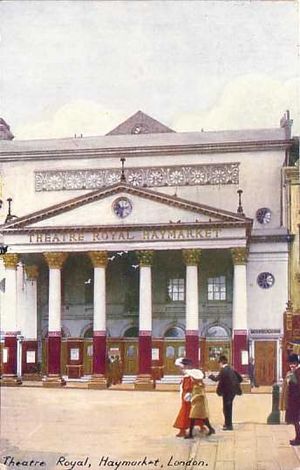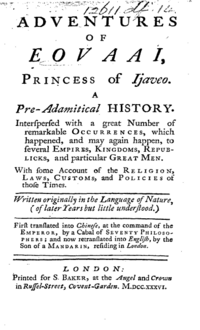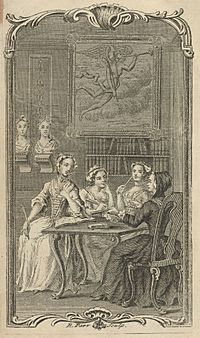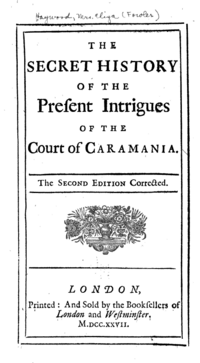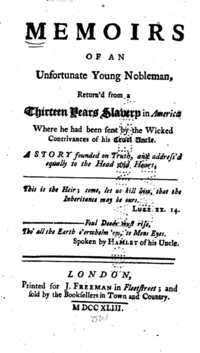Eliza Haywood facts for kids
Quick facts for kids
Eliza Haywood
|
|
|---|---|

Playwright and novelist Eliza Haywood, by George Vertue, 1725.
|
|
| Born |
Eliza Fowler
1693 |
| Died | 25 February 1756 |
| Resting place | Saint Margaret's Church near Westminster Abbey in Westminster |
Eliza Haywood (c. 1693 – 25 February 1756), born Elizabeth Fowler, was an English writer, actress and publisher. An increase in interest and recognition of Haywood's literary works began in the 1980s. Described as "prolific even by the standards of a prolific age", Haywood wrote and published over 70 works in her lifetime, including fiction, drama, translations, poetry, conduct literature and periodicals. Haywood today is studied primarily as one of the 18th-century founders of the novel in English.
Contents
Biography
Scholars of Eliza Haywood universally agree upon only one thing: the exact date of her death. Haywood gave conflicting accounts of her own life; her origins remain unclear, and there are presently contending versions of her biography. For example, it was once mistakenly believed that she married the Rev. Valentine Haywood. According to report, Haywood took pains to keep her personal life private, asking the one (unnamed) person with knowledge of her private life to remain silent for fear that such facts may be misrepresented in print. Apparently, that person felt loyal enough to Haywood to honour her request.
The early life of Eliza Haywood is somewhat of a mystery to scholars. While Haywood was born "Eliza Fowler", the exact date of Haywood's birth is unknown due to the lack of surviving records. Although scholars believe that she was most likely born near Shropshire or London, England, in 1693, her birth date is extrapolated from a combination of her death date and her stated age at the time of her death (Haywood died on 25 February 1756 and obituaries notices list her age as sixty years).
Haywood's familial connections, education status, and social position are unknown. Some scholars have speculated that she is related to Sir Richard Fowler of Harnage Grange, who had a younger sister named Elizabeth. Others have stated that Haywood was most likely from London, England as several Elizabeths were born to Fowler families in 1693 in London; however, no evidence exists to positively confirm any of these possible connections. Her first entry in public records appears in Dublin, Ireland, in 1715. In this entry, she is listed as "Mrs. Haywood", performing in Thomas Shadwell's Shakespeare adaptation, Timon of Athens; or, The Man-Hater at the Smock Alley Theatre. Haywood described herself as a "widow", noting in 1719 that her marriage was "unfortunate", but no record of her marriage has been found and the identity of her husband remains unknown.
Haywood's friendship with Richard Savage is thought to have begun around 1719. Savage wrote the gushing 'puff' for the anonymous Part I of her first novel, Love in Excess. The two appear to have been close in these early years, sharing many associates in literary and theatrical circles, even sharing the same publisher, William Chetwood. By September 1725, however, Savage and Haywood had fallen out, and he anonymously attacked her as a 'cast-off Dame' desperate for acclaim in The Authors of the Town. Savage is considered the likely impetus for Pope's attack on Haywood.
Haywood's association with Aaron Hill and the literary coterie known as The Hillarians seems to have followed a similar pattern as Haywood rose to fame. The Hillarians, a collection of writers and artists "committed to a progressive programme of ameliorating 'politeness'", included Savage, Hill, Martha Fowke, and for a time, Haywood. The group shared poems to and about each other, and formed a social circle of like minds. Haywood seems to have greatly admired Hill—who, though not a patron, seems to have promoted young, up-and-coming artists—and dedicated poems to him. She may have even seen him as a mentor during the earliest years of her career.
William Hatchett was a long-time colleague and collaborator. The two probably met around 1728 or 1729, and recent critics have touted the pair as domestic partners or lovers, though this suggestion has now been challenged. He was a player, playwright, pamphleteer and translator (and perhaps "sponge") who shared a stage career with Haywood, and they collaborated on an adaptation of The Tragedy of Tragedies by Henry Fielding (with whom she also collaborated) and an opera, The Opera of Operas; or, Tom Thumb the Great (1733). They also may have collaborated on a translation of Claude Prosper Jolyot de Crébillon's Le Sopha in 1742. Hatchett has even been seen as the father of Haywood's second child (based on Pope's reference to "a Bookseller" as a father of one of her children, though Hatchett was not a bookseller.) No clear evidence supporting this or a domestic partnership is extant.
Haywood's long writing career began in 1719 with the first instalment of Love in Excess, a novel, and ended in the year she died with the conduct books The Wife and The Husband and contributions to the biweekly periodical The Young Lady. She wrote in almost every genre, often anonymously. Haywood is now considered "the foremost female 'author by profession' and businesswoman of the first half of the eighteenth century", tireless and prolific in her endeavours as an author, poet, playwright, periodical writer and editor, and publisher. During the early 1720s, "Mrs Haywood" dominated the novel market in London, so much so that contemporary Henry Fielding created a comic character, "Mrs. Novel", in The Author's Farce, modelled after her.
Haywood fell ill in October 1755 and died on 25 February 1756, actively publishing up to her death. She was buried in Saint Margaret's Church near Westminster Abbey in an unmarked grave in the churchyard. For unknown reasons, her burial was delayed by about a week and her death duties remain unpaid.
Acting and drama
Haywood began her acting career in 1715 at the Smock Alley Theatre in Dublin. Public records for this year list her as "Mrs. Haywood," appearing in Thomas Shadwell's Shakespeare adaptation, Timon of Athens; or, The Man-Hater.
By 1717, she had moved to Lincoln's Inn Fields, where she worked for John Rich. Rich had her rewrite a play called The Fair Captive. The play only ran for three nights (to the author's benefit), but Rich added a fourth night as a benefit for the second author, Haywood. In 1723, her first play, A Wife to be Lett, was staged.
In the later 1720s, Haywood continued acting, moving over to the Haymarket Theatre to join Henry Fielding in the opposition plays of the 1730s. In 1729, she wrote the tragedy Frederick, Duke of Brunswick-Lunenburgh to honour Frederick, Prince of Wales. George II's son was later a locus for Patriot Whig and Tory opposition to the ministry of Robert Walpole. As he made it clear that he did not favour his father's policies or ministry, praise for him was a demurral. However, when Haywood wrote the play, it is likely that she was still aiming to secure the patronage of the whole royal family, including Queen Caroline, as the royal split had yet to occur. Others, such as James Thomson and Henry Brooke, were also writing such "patriotic" plays (i. e. supportive of the Patriot Whigs) at the time, and Henry Carey would soon satirise the failed promise of George II.
Haywood's greatest Haymarket success came in 1733, with The Opera of Operas, an adaptation of Fielding's Tragedy of Tragedies with music by J. F. Lampe and Thomas Arne). However, it was an adaptation with a sharp difference. Caroline of Ansbach had affected a reconciliation between George I and George II, which meant an endorsement by George II of the Whig ministry. Haywood's adaptation contains a reconciliation scene, replete with symbols from Caroline's own grotto. This enunciated a change in Haywood herself, away from any Tory or anti-Walpolean causes she had supported previously. It did not go unnoticed by her contemporaries.
In 1735, Haywood wrote a Companion to the Theatre. The volume contains plot summaries of contemporary plays, literary criticism, and dramaturgical observations. In 1747 she added a second volume.
After the Licensing Act of 1737, the playhouse was shut against adventurous new plays such as hers.
Fiction
Haywood, Delarivier Manley and Aphra Behn were seen as "the fair triumvirate of wit" and major writers of amatory fiction. Haywood's prolific works moved from titillating romance novels to the amatory during the early 1720s to works, focusing more on "women's rights and position" (Schofield, Haywood 63) in the later 1720s into the 1730s. In the middle novels of her career, women would be locked up, tormented and beleaguered by domineering men, but in the later ones of the 1740s and 1750s marriage became a positive move for men and for women.
Due to the system for paying authors in 18th-century publishing, Haywood's novels often ran to multiple volumes. Authors would be paid only once for a book and receive no royalties: a second volume meant a second payment.
Periodicals and non-fiction
While writing popular novels, Eliza Haywood also worked on periodicals, essays and manuals on social behaviour (conduct books). The Female Spectator (24 numbers, 1745–1746), a monthly, was written in response to the contemporary The Spectator by Joseph Addison and Richard Steele. In The Female Spectator, Haywood wrote in four personae (Mira, Euphrosine, Widow of Quality and The Female Spectator) and took positions on issues such as marriage, children, reading, education and conduct. It was the first periodical written for women by a woman and arguably one of her most significant contributions to women's writing. Haywood followed a lead by contemporary John Dunton who issued the Ladies' Mercury as a companion to his successful Athenian Mercury. Though The Ladies' Mercury was a self-proclaimed women's journal, it was produced by men (Spacks, p. xii).
The Parrot (1746) apparently earned her questions from the government for political statements about Charles Edward Stuart. Mary Stuart, Queen of Scots (1725) is termed a "hybrid" by Schofield (p. 103), as a work of non-fiction that makes use of narrative techniques. Reflections on the Various Effects of Love (1726) is a didactic account of what can happen to a woman when she gives in to her passions. The Wife and The Husband (1756) are conduct books for each partner in a marriage. The Wife was first published anonymously (by Mira, one of Haywood's personas from The Female Spectator); The Husband: in Answer to The Wife followed later the same year with Haywood's name attached.
Haywood also worked on sensational pamphlets on the contemporary deaf-mute prophet, Duncan Campbell. They include A Spy Upon the Conjurer (1724) and The Dumb Projector: Being a Surprising Account of a Trip to Holland Made by Duncan Campbell (1725).
Political writings
Eliza Haywood was active in politics throughout her career, although she changed parties around the time George II was reconciled to Robert Walpole. She wrote a series of parallel histories, beginning with the Memoirs of a Certain Island, Adjacent to Utopia (1724), and then The Secret History of the Present Intrigues of the Court of Caramania (1727). Her Memoirs of an Unfortunate Young Nobleman (1743) fictionalised the life of James Annesley.
In 1746 she started another journal, The Parrot, for which she was questioned by the government on political statements about Charles Edward Stuart, just after the Jacobite rising of 1745. This happened again with A Letter from H---- G----g, Esq. (1750). She grew more directly political in The Invisible Spy (1755) and The Wife (1756).
Translations
Haywood published eight translations of popular continental romances: Letters from a Lady of Quality (1721, translating Edme Boursault's play), The Lady's Philosopher's Stone (1723, translating Louis Adrien Duperron de Castera's historical novel), La Belle Assemblée (1724–1734, translating Madame de Gomez's novella), Love in its Variety (1727, translating Matteo Bandello's stories), The Disguis'd Prince (1728, translating Madame de Villedieu's 1679 novel), The Virtuous Villager (1742, translating Charles de Fieux's work), and with William Hatchett, The Sopha (1743, translating Prosper Jolyot de Crébillon's novel).
As a publisher
Works published under her imprint: Haywood not only wrote works to be published, but participated in the publication process. Sometimes in collaboration with William Hatchett, at least nine works under her own imprint. Most were available for sale at the Sign of Fame (her pamphlet shop in Covent Gardens), including:
- Anti-Pamela by Eliza Haywood (1741)
- Sublime Character of his Excellency Somebody by Unknown (1741)
- Title page states that the work was "Originally Written by a Celebrated French Wit"
- The Busy-Body: or, Successful Spy by Susannah Centlivre (1742)
- The Ghost of Eustace Budgel Esq. to the Man in Blue possibly by William Hatchett (1742)
- The Right Honourable, sir Robert Walpole, (Now Earl of Orford) Vindicated by "A Brother Minister in Disgrace" (1742)
- The Virtuous Villager by Eliza Haywood (1742)
- A Remarkable Cause on a Note of Hand by William Hatchett (1742)
- The Equity of Parnassus by Unknown (1744)
- A Letter from H[enry] G[orin]g by Eliza Haywood (1749)
King notes that the 18th-century definition of "publisher" could also cover bookselling. King is uncertain whether Haywood produced the books and pamphlets that she sold (as Spedding indicates) or whether she was a bookseller, especially for her own early productions. Haywood sometimes collaborated on publishing so as to share the costs, as she did with Cogan on The Virtuous Villager. In any case, Haywood was certainly a bookseller, for many and various works "to be had" at the Sign of Fame did not bare her imprint.
Works by Haywood
Collections by Eliza Haywood published before 1850:
- The Danger of Giving Way to Passion (1720–1723)
- The Works (3 volumes, 1724)
- Secret Histories, Novels and Poems (4 volumes, 1725)
- Secret Histories, Novels, Etc. (1727)
Individual works by Eliza Haywood published before 1850:
- Love in Excess (1719–1720)
- Letters from a Lady of Quality to a Chevalier (1720) (translation of Edme Boursault's novel)
- The Fair Captive (1721)
- The British Recluse (1722)
- The Injur'd Husband (1722)
- Idalia; or The Unfortunate Mistress (1723)
- A Wife to be Lett (1723)
- Lasselia; or The Self-Abandon'd (1723)
- The Rash Resolve; or, The Untimely Discovery (1723)
- Poems on Several Occasions (1724)
- A Spy Upon the Conjurer (1724)
- The Lady's Philosopher's Stone (1725) (translation of Louis Adrien Duperron de Castera's historical novel)
- The Masqueraders; or Fatal Curiosity (1724)
- The Fatal Secret; or, Constancy in Distress (1724)
- The Surprise (1724)
- The Arragonian Queen: A Secret History (1724)
- The Force of Nature; or, The Lucky Disappointment (1724)
- Memoirs of the Baron de Brosse (1724)
- La Belle Assemblée (1724–1734) (translation of Madame de Gomez's novella)
- Fantomina; or Love in a Maze (1725)
- Memoirs of a Certain Island Adjacent to the Kingdom of Utopia (1725)
- Bath Intrigues: in four Letters to a Friend in London (1725)
- The Unequal Conflict (1725)
- The Tea-Table (1725)
- The Dumb Projector: Being a Surprising Account of a Trip to Holland Made by Duncan Campbell (1725)
- The Fatal Fondness (1725)
- Mary Stuart, Queen of Scots (1725)
- The Mercenary Lover; or, the Unfortunate Heiresses (1726)
- Reflections on the Various Effects of Love (1726)
- The Distressed Orphan; or, Love in a Madhouse (1726)
- The City Jilt; or, The Alderman Turn'd Beau (1726)
- The Double Marriage; or, The Fatal Release (1726)
- The Secret History of the Present Intrigues of the Court of Carimania (1726)
- Letters from the Palace of Fame (1727)
- Cleomelia; or The Generous Mistress (1727)
- The Fruitless Enquiry (1727)
- The Life of Madam de Villesache (1727)
- Love in its Variety (1727) (translation of Matteo Bandello's stories)
- Philadore and Placentia (1727)
- The Perplex'd Dutchess; or Treachery Rewarded (1728)
- The Agreeable Caledonian; or, Memoirs of Signiora di Morella (1728)
- Irish Artifice; or, The History of Clarina (1728)
- The Disguis'd Prince (1728) (translation of Madame de Villedieu's 1679 novel)
- The City Widow (1728)
- Persecuted Virtue; or, The Cruel Lover (1728)
- The Fair Hebrew; or, A True, but Secret History of Two Jewish Ladies (1729)
- Frederick, Duke of Brunswick-Lunenburgh (1729)
- Love-Letters on All Occasions Lately Passed between Persons of Distinction (1730)
- The Opera of Operas (1733)
- L'Entretien des Beaux Esprits (1734) (translation of Madame de Gomez's novella)
- The Dramatic Historiographer (1735)
- Arden of Feversham (1736)
- Adventures of Eovaai, Princess of Ijaveo: A Pre-Adamitical History (1736)
- Alternative title The Unfortunate Princess, or The Ambitious Statesman (2nd edition, 1741)
- The Anti-Pamela; or Feign'd Innocence Detected (1741)
- The Virtuous Villager (1742) (translation of Charles de Fieux's work)
- The Sopha (1743) (translation of Claude Prosper Jolyot de Crébillon's novel)
- Memoirs of an Unfortunate Young Nobleman (1743)
- A Present for a Servant Maid; or, the Sure Means of Gaining Love and Esteem (1743)
- The Fortunate Foundlings (1744)
- The Female Spectator (4 volumes, 1744–1746)
- The Parrot (1746)
- Memoirs of a Man of Honour (1747)
- Life's Progress through the Passions; or, The Adventures of Natura (1748)
- Epistle for the Ladies (1749)
- Dalinda; or The Double Marriage (1749)
- A Letter from H---- G-----, Esq., One of the Gentlemen of the Bedchamber of the Young Chevalier (1750)
- The History of Miss Betsy Thoughtless (1751)
- The History of Jemmy and Jenny Jessamy (1753)
- The Invisible Spy (1754)
- The Wife (1756)
- The Young Lady (1756)
- The Husband (1756)
- See also: The Female Spectator (4 vols., 1744–1746). 5th ed., v.3 (London: 1755); 7th ed. (London: 1771)
See also
- List of early-modern British women playwrights
- List of early-modern British women poets



